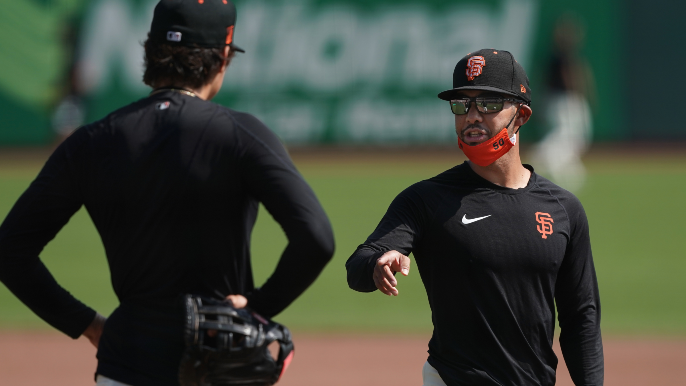
Darren Yamashita-USA TODAY Sports
The Double-A season that began this month represents Major League Baseball’s first step toward combating the falling batting averages that have coincided with the proliferation of defensive shifts. A lot of factors have contributed to action being lost from the game, but a standout is the fact a big lefty’s clean single to right is so often a frustrating out in today’s game.
There may be more tweaks coming, but for the first time in affiliated ball there is an ongoing experiment that aims to see whether the league, and not individual batters, has to adjust to brains taking over defensive play. All four infielders in Double-A games must have their cleats in the dirt when the pitch is delivered.
In the second half of the Double-A season, it’s possible there will be a requirement for two infielders to be positioned on each side of the second base bag. MLB wants to increase batting averages on balls in play, get more runners on base, juice up stolen base tries and drum up excitement for plays that don’t involve walks, home runs and strikeouts.
If the players and the on-field action respond well to these, well, shifts in play in Double-A, it’s possible the big-league game can adopt similar defenses against defensive shifts, especially with a new Collective Bargaining Agreement necessary for play next year.
And if the shift, or forms of it at least, is banned? That would make for a very different world for a Giants coach who takes such pride in defensive alignment.
“I think when the time comes — if there is a real change — then I’ll really have to sit down and think about, OK, how does this influence thought process, strategy, general day-to-day workflow,” infield and bench coach Kai Correa said during spring training.
The work of Correa, as well as the Giants’ analytic team and players who come together to decide how to best position against opposing hitters, is most noticed when it doesn’t work, the accidental flares or nice pieces of hitting that find holes. But the optimized positioning is relentless and indisputably effective; last year, the Giants ranked sixth in baseball, according to SportsInfoSolutions, in turning ground balls and bunts into outs.
Through the first seven weeks of this season, the Giants’ defensive shifting is down — from 31.5 percent of the time last year to 21.6 percent this year, the fifth least often in baseball. It’s working, with opponents entering the Diamondbacks series batting .271 on batted balls in play, the Giants’ mark the ninth best in MLB.
The way Correa explains the Giants’ process into best positioning their defense might make you hungry. Major League Baseball distributes the same batted-ball data to every team. It’s the “same store-bought pasta sauce” that everyone has.
“Recency, specificities of pitcher and matchup, your defense, the surface, all of that are the garlic, the onions — the things that the chef does in the kitchen before it goes to the table that can elevate that store-bought pasta sauce,” Correa said over the phone. “And then finally the players’ experience: That’s like the salt, the pepper and the parmesan that’s on the table. That’s taster’s choice — Brandon Crawford has been doing this a long time, and he knows what he likes. And I think if you have a really good process with the ingredients you add in, you can elevate the same data that everyone’s got.”
He understandably does not want to reveal how heavily the Giants weigh each ingredient, but it’s a lengthy process that ends with outfield coach Antoan Richardson waving the outfielders a few steps over with a towel; with Evan Longoria dashing from third to second and maybe back again all within one batter, depending upon the count.
The process that is seen now for Correa got its seeds when he coached college baseball, first at Washington’s Puget Sound and then at the University of Northern Colorado.
He had players whose skill sets might sound familiar — solid bats who were not known for their gloves — and tasked himself with finding a way they could fit.
“Instead of saying like the old adage — he can’t catch it, he can’t play infield — it’s like, no, you can put people in positions to succeed and have a net positive in the game,” said the 32-year-old, who had been a defensive coordinator with Cleveland before Gabe Kapler plucked him before the 2020 season. “And having coached those places that were less notable college programs, my thought process was: Instead of trying to find the most ideal, complete player, trying to put the best team on the field. And oftentimes that led to us having to work harder to have guys in the right spot.”
Correa, of course, will adapt if he needs to. If shifts (or partial shifts) are done away with in 2022, his time would open up and there will be new challenges in which he can try to outthink opponents. But it is a testament to coaching and to advanced analytics that have enabled teams as disparate as the Northern Colorado Bears and San Francisco Giants to discover ways to get bats into lineups while hiding gloves that could be exploited otherwise.
It is also a testament to a game that allowed this maneuvering — but maybe not for long.

